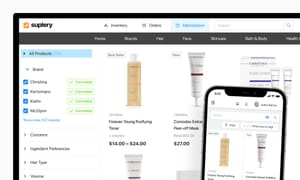How to start a hair business with no money 2025 | Practice-based guide
Are you tired of working for someone else and dreaming of starting your own business in the hair industry? Do you have a passion for hair and beauty but are unsure how to start a hair business with no money?
Well, don't let a lack of money stop you from pursuing your dreams! The hair care market is projected to reach a revenue of $13.44 billion in 2023, and there's a great opportunity for you to claim your portion of that sum.
In this ultimate guide, we'll show you how to turn your love for hair into a successful and profitable business, even if you have never been an entrepreneur before.
So, let's get started and turn your hair business dreams into a reality.
Is it possible to start a hair business with no money?
Normally, experts advise starting a business in the hair industry with at least $10,000 to $20,000 for a small one-chair hair salon, where the exact sum depends on its location, equipment, and overall level.
However, it’s realistic to start a hair business without such investments. Still, you will need some funds for essential expenses such as:
- Business registration, licenses, and permits—from $50 to $500 or more.
- Hair styling tools (scissors, combs, brushes, hair dryers, etc.)—from $100 to $500 or more, depending on the brand and quality.
- Hair products (shampoos, conditioners, and styling products)—from $200 to $500 or more for the initial product inventory.
- Salon or workspace rental (rent, utilities, and other expenses)—from $500 to $2,000 or more per month, depending on the location, size, and quality of the space.
To make it with modest finances, there are multiple ways to cut your costs along the way, and we’ll tell you about the best of them.
8 steps to start a hair business with no money
Opening your own hair business is always a challenge, and doing it without investments is doubly so. This means you will need to plan everything precisely and check yourself before making any payments. But it’s definitely doable, so let’s go through the hows!
1. Research your market
Market research is a necessary first step, especially when starting a hair business with no money. It helps you avoid financial loss caused by mismatching your target audience, overspending where it was possible to save, or overlooking changes in the hair industry you might have missed.
Here’s what you need to do:
- Learn about your target audience. Think about your ideal customer and their needs and budgets, and align this information with your vision of a salon you want to open. You can conduct live interviews with your potential customers, e.g., your friends and their friends, or you can survey people on the street or in social media—use online tools such as Google Trends or Facebook Audience Insights to gather data on the demographics and behaviors.
- Think about the location. It’s very important that your target audience is present in the district where you will locate your hair business. Check out where people live or work there, what their daily routines are, and whether there’s a sufficient number of people you are targeting to satisfy your need for customers.
- Analyze your competition. Research the number of competitors (hair salons, hair vendor companies, barbershops, or others relevant to your idea) in the area. Their size, types of services, prices, and especially customer reviews will give you precious insights about how to start your business. To get this information, you can both visit their salons personally and look at their websites, social media pages, and online reviews on various sites.
- Evaluate the viability of your business idea. Based on the above, estimate whether your initial idea is viable or should be adjusted to better align with reality. You might want to open a salon in another place because there’s too much competition, the level of prices may be different from what you thought, or you might want to consider opening a hair-selling business instead of a wig business because of the market structure.
- Develop a marketing strategy. Summarize your research with a high-level strategy that will include your positioning (services, prices, unique value proposition, marketing budget, if any) and main methods to promote the services you can ideate on this level.
Also, there are specific kinds of research you can perform to save extra money:
- Equipment suppliers. Before you go any further, research various equipment suppliers to find the best deals and negotiate lower prices. Some suppliers may offer financing options or lease-to-own arrangements that can help you spread out your payments.
- Location options. Evaluate different location options in the chosen area to ensure it’s what you can afford. Consider such factors as rent, utilities, and the cost of renovations if needed.
- Staffing needs. If you need staff at the earliest stage of your business, research different options for hiring stylists and other employees and the correlation between their professional level and desired income. Consider offering commission-based compensation instead of a salary to cut down on fixed costs.
Add the results of this additional research to your vision and continue with the next step.
2. Create a business plan
You might think that if you’re a small business, you won’t need this huge and complicated business plan. If so, you’re both right and wrong. You might need a very simple business plan with just the essential info included. However, it’s crucial for success. If you're wondering how to start a hair business with no money and not having an "extra" budget to risk, proper planning is your key to success
Your business plan is the entrepreneurial map that will help you:
- Formulate your goals and objectives into a simple path to follow;
- Organize your required expenses into a plan;
- Summarize what you need to remember about your target audience and competition;
- Outline the marketing strategies you will be using very soon.
Here’s a structure for a very basic business plan you can use:
| Section | Description |
|---|---|
Concept and vision | A formulation of the general concept: What will your hair business look like (will you be selling hair extensions?; will it be a hair salon, barbershop, wig business, hair vendor, or something else)? How small or big is it going to be?Which services are you going to offer?What products are you planning to use?How are you going to position yourself?What will your long-term goals be? |
Industry analysis | Current information about the industry that may influence your actions: e.g., if the industry is in crisis because of a geopolitical situation, or, on the contrary, if it’s on the rise after recent events, you may want to take this into account. Also, there should be location-specific information like local trends, potential challenges, and opportunities you have noticed. |
Customer analysis | It’s what you learned about your customers in the area: their demographics, income levels, buying habits, daily routines, and other preferences. |
Competition analysis | It’s what you learned about your competitors: their density in the area, services, prices, kinds of positioning, strength, weaknesses, etc. That will help you stand out from the crowd with your hair business. |
Marketing plan | Your value proposition, main benefits, list of services, pricing strategy, sales channels, and types of promotions you are going to introduce. |
Business operations plan | An outline of your management team structure, the required qualifications for key employees you are planning to hire, and your day-to-day operations, including inventory management, staffing, and customer service policies. |
Financial plan | An overview of your potential sources of funding, financial projections, including your opening costs, ongoing expenses, and cash flow and income forecasts. |
Executive summary | A concise summary of the key points from each section of the business plan will help you wrap it up and quickly return if anything important should be clarified along the way. |
3. Register your business
After your plan is set up, it’s time to start your business registration process, and here’s what it will look like:
Research and obtain the necessary permits and licenses required for your hair business, such as a general business license, seller’s permit, and zoning permit. Visit your local SBA (Small Business Administration) office and the Department of Revenue in your state to find out which agencies you need to apply to.
- Choose a unique name that is not already protected by another trademark and check its availability in the trademark database. If you struggle with ideas, you can search for a business name generator.
- Draft an operating agreement if you plan to operate as an LLC or create and sign a partnership agreement if you plan to operate as a partnership with someone else.
- Register with the Secretary of State through your state's official website and pay the registration fee. After submitting the required information, you will receive a file number, and your entity will be added to the state's online records.
- Register for taxes and obtain an Employer Identification Number (EIN) from the Internal Revenue Service (IRS).
This process may take some time, so you can proceed with the next steps even before the registration process is finished. At least you can start researching the options.
4. Choose the location and make it pretty
Even—and especially—if you have a minimum budget, choosing the right location will be a crucial point when starting a hair business with no money for your future successful hair business. Here are some tips that will help you do it right and save money at the same time:
- Choose the location wisely. When opening a hair business with little money, it's crucial to choose a location that is both affordable and strategic. Look for a space easily accessible to your target audience and has high foot traffic, like a busy street or shopping center. Try to find a place that looks good without renovation because it may take a great deal of money.
- Keep it simple. When it comes to decorating your salon, simplicity is key. Opt for a neutral color scheme and simple, modern furnishings. Look for affordable decor pieces at thrift stores, garage sales, or discount retailers. Consider DIY decor projects to add a personal touch to your salon.
- Invest in quality equipment. While you may be tempted to skimp on equipment to save money, investing in quality tools and equipment can make a big difference in your successful hair business. Choose high-quality chairs, styling tools, and other equipment that will last for years to come—this will not only help you save money in the long run but also let you position your salon as a professional and quality space to come.
Even with a small salon, it's essential to focus on creating a great customer experience. A comfortable chair for waiting, fresh cool water, a coffee machine, candies and cookies, pleasant music, and photographs of your happy customers — such small details may make your salon pleasant to visit.
5. Purchase supplies
If you have a very limited budget, purchasing supplies for your hair salon can be challenging, but there are still several options to help you save money:
- Start with the essentials. There may be a ton of things that are nice to have, but when you don’t have much money, it’s important to focus on purchasing only the essentials first. This may include basic supplies like scissors, combs, brushes, towels, and styling products. As your business grows, you can invest in more specialized equipment and products.
- Look for sales and discounts on beauty supply websites or in stores. You can also consider purchasing supplies in bulk to take advantage of volume discounts, for example, hair care products, towels, gloves, etc.
- Buy secondhand equipment. You can save money by purchasing gently used equipment like chairs, mirrors, and shampoo bowls. Check out online marketplaces like Craigslist or Facebook Marketplace or visit local beauty supply stores that may sell used equipment but make sure it looks and functions well.
- Consider alternative suppliers. You may already know some suppliers you want to work with. Still, it’s much more profitable to order things online on a platform like Suplery, which provides easy access to a greater variety of suppliers and their different offers compared to an offline or online store.
It’s always important to prioritize quality over price as much as you can. Your hair salon, even if it has only one chair, has to look like a place where someone wants to come and trust their beauty to your hands.
6. Establish an inventory management
Managing inventory is important for any beauty business, especially one with a limited budget. Shortages, products that have gone out of date, and other similar problems can cause big problems and lead to lost money. Because of this, it is important to set up a good inventory management system from the very beginning.
The Suplery– the inventory management platform is designed specifically for beauty businesses. It will help you:
- Keep track of inventory (hair care products, styling products, hair extensions, and more) and stock balances in real-time;
- Avoid product shortages and excess stock;
- Receive timely notifications about your inventory status;
- Order products from the best beauty brands and suppliers;
- Automate orders based on usage history, existing stock, and safety stock amount;
- Gain valuable insights about product usage and ordering.
With Suplery, it's easier to keep track of your inventory. As a hair salon owner, you can spend your time giving services and running your business instead of spending hours figuring out what products are out of stock or have expired.
7. Hire staff
When hiring staff for a hair business with no money to risk, it's important to carefully consider the positions you need to fill to keep costs low. Maybe you will be a one-person business at the first stage, but if not, here are the steps to follow:
- Determine the necessary positions, such as hair stylist, receptionist, and cleaning manager.
- Calculate the number of hours each person will need to work, taking into account the number of clients you expect to serve and your budget constraints.
- Place vacancies online, offline, and on the doors of your salon if you already have a location. Tell your friends and colleagues you are hiring.
- Create written criteria for each position and take notes during interviews to compare candidates objectively.
- When interviewing candidates, consider their experience, skills, certifications, customer service attitude, and cultural fit rather than the cheapness of their working hours. Choose candidates who align with your salon's values and mission.
- Sign employment contracts with each of those whom you want to hire.
Of course, it's important to keep costs low, but it’s even more important to start well and quickly gain a reputation as a small yet great hair business with highly professional and friendly staff. So when hiring your first employees, it’s crucial to prioritize professionalism and human qualities. If you're wondering how to start a hair business with no money, considering the use of apprentices might be a good option, provided that the most complex tasks are managed by an experienced professional, either you or your employee.
8. Open it
Finally, you are ready to do it—open your own hair business!
Even if you don’t want to spend too much money on the opening ceremony, don’t skip it completely. Instead, you can make it simple yet heartwarming:
- Keep the guest list small. Invite only your closest friends, family, and current clients to keep the guest list manageable.
- Offer simple refreshments. Provide affordable food and drinks, such as cupcakes and bottled water, or consider asking your guests to bring their own beverages.
- Create simple marketing materials. Use social media and free online platforms to promote your opening instead of costly print materials. Or, if you have the budget, printing flyers your guests may give to their friends won’t hurt.
- Greet your guests heartily and thank them for attending. Giving them simple presents like hair care product testers or your own printed advice about how to make their hair look well may be a good idea.
- Focus on personal interaction. Instead of offering activities or giveaways, focus on the personal experience: greet guests personally, tell them about your salon and its concept, give them short, free consultations, provide them with light snacks and beverages, etc.
The opening is meant to show potential customers what your salon is like and give them a good first impression. Keep things simple yet welcoming in a way that will make them want to come again and recommend you to their friends.
More budget-saving tips for starting a hair business no money
Are you still thinking about how to start an online hair store with no money down? Additional ways to cut your budget when you start a hair business with no money include:
- Consider offering apprenticeships to newly licensed professionals who are looking to gain experience—this may provide you with affordable staffing.
- Partner with local beauty schools, allowing them to practice their skills and gain experience while providing you with a cost-effective staffing solution.
- Buy in bulk. Purchase your salon supplies, such as hair products, styling tools, and hair extensions in bulk to save money on the unit cost.
- Negotiate the lease terms with your landlord, such as rent, security deposit, and length of the lease to help reduce your monthly expenses.
- Go paperless. Use digital tools to streamline your salon operations, such as online booking, electronic invoicing, and inventory management. This will help you save money on paper, printing, and postage costs and release your time for doing business instead of sorting through papers.
- DIY marketing. Instead of hiring a professional marketing firm, begin with designing your own marketing materials, such as flyers, social media posts, and email newsletters, by using free tools like Canva or similar.
- Consider working with freelancers for certain services, such as graphic design, website development, or marketing. This can help you save money on salaries and benefits for full-time employees.
- Use social media platforms like Facebook, Instagram, and Twitter to promote your salon and its services instead of spending money on traditional advertising methods like print ads and online PPC campaigns.
- Offer package deals for your services, such as a haircut and color package, to encourage customers to purchase more services at once.
- Leverage referral marketing. Encourage your satisfied customers to refer their friends and family to your salon in exchange for a discount or other incentive. This can be an effective way to attract new customers without spending money on advertising.
Wrapping up
How do you start a hair business with no money? Regardless of how challenging it may seem at first sight, it’s totally possible to accomplish, and thousands of people do it every year. While it may take a bit more effort, management, and strategies to get past the obstacles money can easily solve, it is the end result that matters most.
Creating a well-thought-out business plan, starting small, and using free tools to promote yourself will help you accomplish your goal gradually.
Suplery can help you grow your hair business by delivering professional-grade products right to your door and keeping track of your stock. This is particularly valuable when you're learning how to start a hair business with no money, as you, the owner, will need to handle many tasks independently. So, it’s always better to focus on your business's essentials rather than drown in stuff that can easily be automated.
Stay ahead in beauty business
Feast on the latest marketing techniques and business tips. Elevate your game with every read!
Unveil secrets Master business fundamentals step-by-step
Master business fundamentals step-by-step
Subscribe now for actionable how-to guides, foolproof business strategies, and practical advice. Transform your "how-to" questions into successful business actions today!
Oh no! We couldn’t subscribe you ☹️
Done! You've subscribed 💛
Unsubscribe anytime. Your data is stored for business-to-business communication purposes. See our Privacy policy.
Frequently asked questions
How much does it actually cost to start a hair business
Usually, it’s advised to have $10,000 to $20,000 to start a hair business smoothly, but it’s totally possible to cut costs and start with $2,000 or $5,000, which is close to starting a hair business with no money. The exact sum will depend on your location, size, supplies, and other factors.
Is it possible to start a hair business with no money successfully?
Thousands of people do it every year. However, some expenses are unavoidable, such as licenses and permits ($50-$500), tools ($100-$500), hair styling supplies ($200-$500), and workspace rental ($500-$2,000).
How do I start a hair business with no money?
To start a hair business without money to invest, you’ll need to do proper initial research, create a business plan, and search for ways to cut costs all along the way. There are many ways to do that, such as negotiating the location price, purchasing slightly-used equipment, hiring apprentices, etc.
Last updated on Apr 15, 2025
“What Changed” in this article? Everything. It's packed with the latest findings, the ripest data, and a fresh analysis you won't find anywhere else.
Please share this post
Unlock the secrets to beauty business success!
Join our community for insider tips on product management, marketing, sales and client attraction. Elevate your business with expert insights delivered straight to your inbox.
Oh no! We couldn’t subscribe you ☹️
Done! You've subscribed 💛
Trusted by the best in the beauty industry.
Transform your beauty business with Suplery!
Already enjoying our expert tips? Take the next step and join Suplery to revolutionize your business operations.
Huge range of professional products
One-click checkout after first order
Automated predictive orders
Seamless inventory management
From words to action
Start working with Suplery and explore all the tools and services you need to expand your business
Get started with Suplery24/7 Support
Secure payments
Designed by industry’s experts



